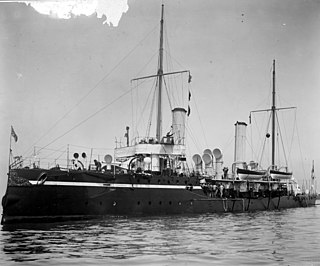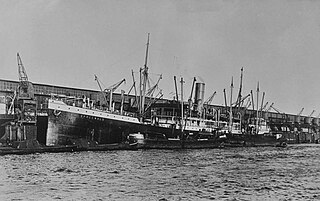
Ryusei Maru was a cargo steamship that was built in England in 1911 and sunk off the coast of Bali in 1944. Sit was launched as Bra-Kar for Fred. Olsen & Co. of Norway. In 1916 it changed owners and was renamed Havø. In 1935 it changed owners again and was renamed Mabuhay II.

Tango Maru (丹後丸) was a cargo motor ship that was built in Germany in 1926 and sunk off the coast of Bali in 1944. She was launched as Rendsburg for the Deutsch-Australische Dampfschiffs-Gesellschaft (DADG), which in 1926 merged with Hamburg-Amerikanische Packetfahrt-Actien-Gesellschaft (HAPAG).

HMCS Arras was one of twelve Battle-class naval trawlers that saw service with the Royal Canadian Navy (RCN). The vessel entered service in 1918 near the end of the First World War and was used for patrolling and escort duties along the Atlantic Coast of Canada. Following the war, Arras was transferred to the Department of Marine and Fisheries where the ship was used as a fisheries patrol vessel. Following the outbreak of the Second World War, the ship re-entered RCN service as a gate vessel. In 1943, the ship was heavily damaged by fire and was broken up in 1957.

HMCS Givenchy was one of twelve Battle-class naval trawlers constructed for and used by the Royal Canadian Navy (RCN) during the First World War on the east coast. Following the war, the ship was transferred to the Department of Marine and Fisheries for use as a fisheries patrol vessel on the west coast. Givenchy reentered service with the RCN in 1939 as an accommodation ship during the Second World War and was recommissioned from 1940 to 1943. After the war the ship was sold and broken up in the United States in 1952.

SS Minnedosa was one of a pair of transatlantic steam ocean liners that were built in the United Kingdom, launched in 1917 and operated by Canadian Pacific until 1935. Her sister ship was Melita.

MV Spreewald was a Hamburg America Line (HAPAG) cargo motor ship that was launched in 1922 and sunk in a friendly fire incident in 1942. She was renamed Anubis in 1935, and reverted to her original name Spreewald in 1939.
SS Empire Bunting was a 6,318 GRT cargo ship which was built in 1919. She saw service between the wars under the US flag and was transferred to the UK Ministry of War Transport in the Second World War. She made a number of cross-Atlantic voyages, often sailing in convoys. She ended her career by being sunk as a blockship on the Normandy coast, supporting the allied landings there in 1944.

HMS Port Quebec was a British motor ship that was designed and launched in 1939 to be the refrigerated cargo ship Port Quebec, but completed in 1940 as an auxuiliary minelayer. In 1944 she was converted into an aircraft component repair ship and renamed HMS Deer Sound. In 1947 she was returned to her owner, Port Line, and completed as a cargo ship. She was scrapped in Taiwan in 1968.
MV Dumana was a British cargo liner that was laid down as Melma, but launched in 1921 as Dumana. The British India Steam Navigation Company (BI) owned her, and ran her on routes between London and India.

Davara was a British steam fishing trawler. Launched in 1912, it was requisitioned in 1914 by the Royal Navy for service in World War I and fitted out as a minesweeper. She was returned to her owners after the war and began service as a trawler once more.
SS Burgondier was a 5,297-ton cargo steamship built to a First World War standard design by Caird & Company at Greenock on the Firth of Clyde. She changed owners and names several times, becoming the Azul, David Dawson, Penteli and finally Brockley Hill. She was sunk by enemy action in 1941.

The Kil class was a class of sloops, also referred to as gunboats, built for the Royal Navy during the First World War. They were designed for anti-submarine warfare, but were completed too late in the war to be used extensively in that role. They were designed to be double-ended to confuse submarine observers, and were painted in dazzle camouflage. Following the war, the majority of the class were sold off and converted to coastal cargo vessels.

HMS Agamemnon was originally the Blue Funnel Line refrigerated cargo ship Agamemnon. She was built in 1929, traded between the United Kingdom and the Far East, and was scrapped in 1963. During the Second World War she was converted into an auxiliary minelayer in 1940, and then into an amenities ship in 1943.

HMS Circe was a Alarm-class torpedo gunboat of the British Royal Navy. She was built by Sheerness Dockyard from 1890–1893. She was converted to a minesweeper in 1908–1909 and continued these duties during the First World War. Circe was sold for scrap in 1920.
HMS Leda was an Alarm-class torpedo gunboat of the British Royal Navy. She was built by Sheerness Dockyard from 1891–1893. She was converted to a minesweeper in 1908–1909 and continued these duties during the First World War. Leda was scrapped in 1922.

HMS Speedy was a Alarm-class torpedo gunboat of the British Royal Navy. She was built by Thornycroft from 1892–1894. She was converted to a minesweeper in 1908–1909 and continued these duties during the First World War. Speedy was sunk by a German mine on 3 September 1914.
HMS Skipjack was a Sharpshooter-class torpedo gunboat of the British Royal Navy. She was built at Chatham Dockyard from 1888–1891. She was converted to a minesweeper in 1908–1909 and continued these duties during the First World War. Skipjack survived the war and was sold for scrap in 1920.
The German trawler V 406 Hans Loh was a steam trawler that became a Vorpostenboot in the Second World War. She was launched in Germany in 1936 as Hans Loh. In September 1939 she was converted into the VorpostenbootV-402. That October she was renumbered V-206. A mine sank her in the Gironde estuary in August 1942, killing 18 members of her crew.
Rauzan was built as the British fishing trawler Earl Hereford. Sold to the Faroe Islands in 1912, she was purchased by the French Navy in 1917, serving as the patrol boat Guénon. She was sold in 1919 and was renamed Pen-er-Vro. Renamed Rauzan by 1930, she was requisitioned by the Kriegsmarine during the Second World War for use as a vorpostenboot, serving as V 421 Rauzan. She was sunk in June 1944.

HMS Lucia was a steamship that was launched in England in 1907 as the passenger and cargo ship Spreewald for Hamburg America Line (HAPAG)'s Caribbean services. The Royal Navy captured her in 1914, and renamed her Lucia. Elder Dempster Lines managed her until 1916, when she was converted into the submarine depôt ship HMS Lucia.













